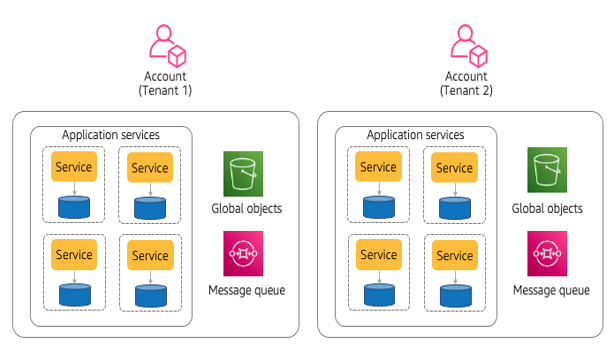Full Stack Silo in Action
Now that we have a good sense of the full stack silo model, let’s look at some working examples of how this model is brought to life in real-world architecture. As you can imagine, there are any number of ways to implement this model across the various cloud providers, technology stacks, and so on. The nuances of each technology stack adds its own set of considerations to your design and implementation.
The technology and strategy you use to implement your full stack silo model will likely be influenced by some of the factors that were outlined above. They might also be shaped attributes of your technology stack and your domain realities.
The examples here are pulled from my experience building SaaS solutions at Amazon Web Services (AWS). While these are certainly specific to AWS, these patterns have corresponding constructs that have mappings to other cloud providers. And, in some instances, these full stack silo models could also be built in an on-premises model.
The Account Per Tenant Model
If you’re running in a cloud environment–which is where many SaaS applications often land–you’ll find that these cloud providers have some notion of an account. These accounts represent a binding between an entity (an organization or individual) and the infrastructure that they are consuming. And, while there’s a billing and security dimension to these accounts, our focus is on how these accounts are used to group infrastructure resources.
In this model, accounts are often viewed as the strictest of boundaries that can be created between tenants. This, for some, makes an account a natural home for each tenant in your full stack silo model. The account allows each silo of your tenant environments to be surrounded and protected by all the isolation mechanisms that cloud providers use to isolate their customer accounts. This limits the effort and energy you’ll have to expend to implement tenant isolation in your SaaS environment. Here, it’s almost a natural side effect of using an account-per-tenant in your full stack silo model.
Attributing infrastructure costs to individual tenants also becomes a much simpler process in an account-per-tenant model. Generally, your cloud provider already has all the built-in mechanisms needed to track costs at the account level. So, with an account-per-tenant model, you can just rely on these ready made solutions to attribute infrastructure costs to each of your tenants. You might have to do a bit of extra work to aggregate these costs into a unified experience, but the effort to assemble this cost data should be relatively straightforward.
In Figure 3-5, I’ve provided a view of an account-per-tenant architecture. Here, you’ll see that I’ve shown two full stack siloed tenant environments. These environments are mirror images, configured as clones that are running the exact same infrastructure and application services. When any updates are applied, they are applied universally to all tenant accounts.

